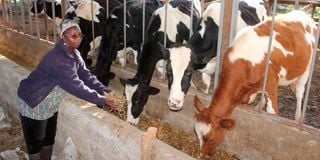Premium
Practices to help you survive harsh weather pattern

Josphine Kirui feeds her zero-grazing dairy cows silage at Tegat Farm in Elburgon, Nakuru County. The use of silage as a feed helps farmers to build climate resilience.
What you need to know:
Farmers need to assess their financial capability and farm operations to implement the adaptation measures that suit their farms.
As climate experts gather in Egypt tomorrow for the COP27 meeting, one of the things that would top the discussions is how resilience in the agriculture sector can be enhanced as climate change effects fast unravel across the world.
In Kenya, farmers are grappling with the effects of the worst drought in decades as pasture and water become scarce amid a rise in pests and diseases. All these challenges require farmers to improve on their adaptation capacities.
This is how it can be done for livestock keepers:
On-farm forage production
During extended dry periods, forage becomes scarce and expensive. A bale of hay is currently going for up to Sh400. Increasing resilience calls for growing improved forage varieties adaptable to low precipitation or low agroecological zones, increased temperatures and short growth cycles.
To boost production amid scarcity, farmers need to plant improved grasses like hybrid brachiaria, camello and Panicum maximum varieties; forage grain crops like sorghum fodder and pearl millet and fodder trees.
In rangelands, there is a need to increase forage crop diversity and reseeding by introducing locally-adapted high-value pasture grasses like African foxtail, Maasai love grass and horsetail as well as rangeland trees.
This calls for seeking expert services, and the use of optimum field agronomic practices such as scheduling irrigation, use of organic fertilisers and weeding and pest control. The benefit of growing pastures is that they reduce land degradation protecting the soil structure and fertility.
Forage conservation
Seasonality in feeds disrupts milk production. Greater resilience calls for intensification, including outsourcing of fresh, conserved forage and agro-industrial by-products like concentrates. Making silage and hay from grasses and legumes, both of good quality helps.
There is also a need for good storage barns (hay) and silos (silage) to minimise losses and damage of conserved feed. This will keep one afloat during rainy days.
Soil and pasture care during open grazing
Limited capacity to rehabilitate grasslands leads to degradation of pasture and landscape hence loss of soil fertility, especially in the pastoral communities. This makes the lands less suited for arable farming and results in overgrazing and over-dependence on natural pastures that are limited during periods of drought.
Planned grazing in terms of total livestock capacity or unit and duration will reduce over-dependence on pasture and its sustainability, as well as curb land degradation. As the drought worsens and feeds become scarcer, monitor the movement of your animals or adopt a paddock system.
Water
A progressive decline in precipitation affects water availability and livestock productivity. Forecasting water status allows producers to examine risks and identify potential responses. For example, existing farm water storage points should be filled with quality water as cattle refuse to drink dirty water. At individual farms, adopt low-maintenance technologies like water harvesting to deal with both abundance and scarcity.
In the long term, sinking boreholes and protecting critical water catchment areas and special community water ecosystems are good options.
You can also reduce stocking pressure by culling, selling or leasing stock to reduce feed demand to allow for better nutrition of the remaining animals.
Heightening management of vulnerable cow
Poor care and nutrition lead to under-feeding (negative energy balance hence loss of body condition score) and consequently lowers reproductive performance in cattle. In-calf cows, for example, need closer attention and feeding at such times. Extra feed will be required for them and their soon-to-be-born offspring. Calves and heifers also need the right care and nutrition for growth and body maintenance.
Stress occurs when the heat load is greater than an animal’s capacity to lose it. During extended dry periods, cattle are under physical stress. Young stock is particularly very sensitive to dry weather stress so should be monitored regularly to keep them in good health conditions. Effect minimum measures like providing clean drinking water at all times, offering shade, and reducing walking distance and speed of the cows during grazing.
Disease and parasite control
A rise in temperature leads to a surge in incidences of pests and diseases, resulting in a drop in productivity, loss of body weight, lowered immunity, sick cattle and death. Nonetheless, disease transmission and parasites are increased in crowded conditions around water and feed sources. Observe routine external parasite control, changing acaricides effectively while for internal parasites, administer registered products according to label instructions.
Enhance disease surveillance protocols and biosecurity on your farm and keep your veterinarian in close contact.
Climate-smart agriculture
Technologies that incorporate minimum tilling, integrated pest management and recycling of farm waste to make biogas on dairy farms are good mitigation measures.
Increasing forest cover through the planting of trees (reforestation) such as rangeland species like acacia and integrating sustainable farming practices will assist in combating the effects of possible future drought.
Farmers need to thoroughly assess their financial capability and farm operations to implement the adaptation measures that suit their farms.
The strategies need to be flexible, continually reassessed and adjusted to fit changing circumstances.
The writer is based at AgriDairy Innovations.





